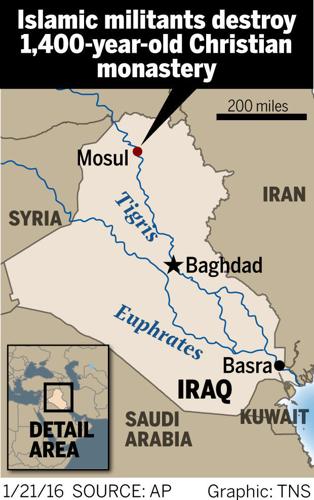The earliest Christian monastery in Iraq was destroyed by the Islamic State, and with it two years of work by a University of Arizona professor.
Satellite images confirmed the 1,400-year-old St. Elijah’s Monastery of Mosul reduced to rubble, joining the ranks of more than 100 ancient sites destroyed by the Islamic State, The Associated Press reported Wednesday.
For Suzanne Bott, project director at the UA’s Drachman Institute, the news was “heartbreaking” but not altogether unexpected.
From 2008 to 2010, Bott and a team of researchers did reconstruction work at the monastery alongside U.S. troops living at the Marez/Diamondback military base.
She and her colleagues found a large complex of earth and stone, including a church, sanctuary, altar and vaulted ceilings, rising above a terraced landscape where olives and fruit trees grew centuries ago.
They also found a niche where a “lovely” scallop shell design bore an inscription asking for prayers for the people buried beneath the walls, she said.
Since the rise of the Islamic State, Bott and her colleagues feared the group would destroy the monastery at some point, she said. Now, those fears have been confirmed.
“I’m infuriated,” she said.
Ancient sites such as the monastery can teach and unify people, she said, including the U.S. troops who learned about the history of the area by visiting the monastery.
Christians first settled the area around the monastery in the third century, Bott said. About 300 years later, the monastery was built on the outskirts of town. The roughly 100 monks who lived there offered medicine to the townspeople and welcomed orphans.
The monastery survived for centuries until 1743, when a Persian leader forced everyone to convert to Islam.
The monks refused to convert and were put to death. The monastery was abandoned and fell into ruin, but served as a refuge during World War I and was later occupied by the Iraqi Army, Bott said.
After initial damage caused by U.S. troops during the invasion of Iraq, an Army chaplain realized the religious significance of the monastery and in 2004, with the backing of Gen. David Petraeus, told the troops to leave it alone. From then on, services were held on Easter and Christmas for the troops, Bott said.
In his office in exile in Irbil, Iraq, the Rev. Paul Thabit Habib, 39, stared quietly at before- and after-images of the monastery that once perched on a hillside above his hometown of Mosul. Shaken, he flipped back to his own photos for comparison.
“I can’t describe my sadness,” he told the AP in Arabic. “Our Christian history in Mosul is being barbarically leveled. We see it as an attempt to expel us from Iraq, eliminating and finishing our existence in this land.”
“A big part of tangible history has been destroyed,” said the Rev. Manuel Yousif Boji. A Chaldean Catholic pastor in Southfield, Michigan, he remembers attending Mass at St. Elijah’s almost 60 years ago while a seminarian in Mosul.
“These persecutions have happened to our church more than once, but we believe in the power of truth, the power of God,” Boji told the AP.
He is part of the Detroit area’s Chaldean community, which became the largest outside Iraq after the sectarian bloodshed that followed the U.S. invasion in 2003. Iraq’s Christian population has dropped from 1.3 million then to 300,000 now, church authorities say.







